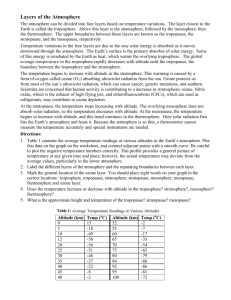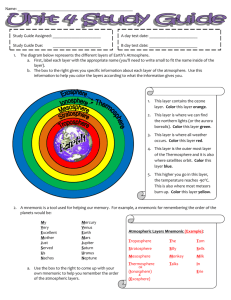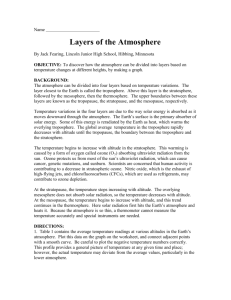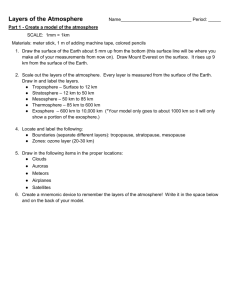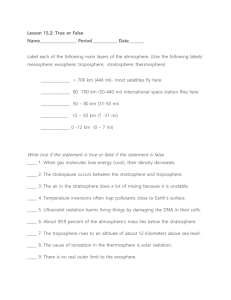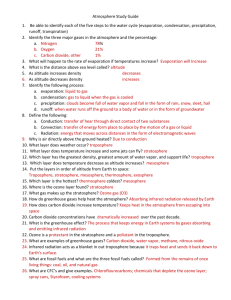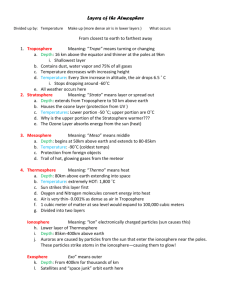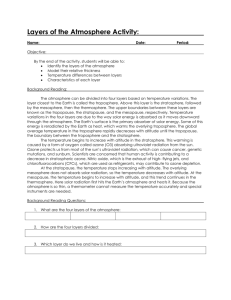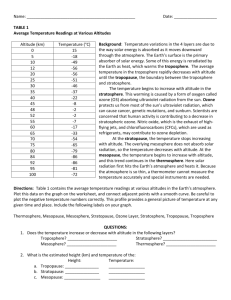Activity
advertisement
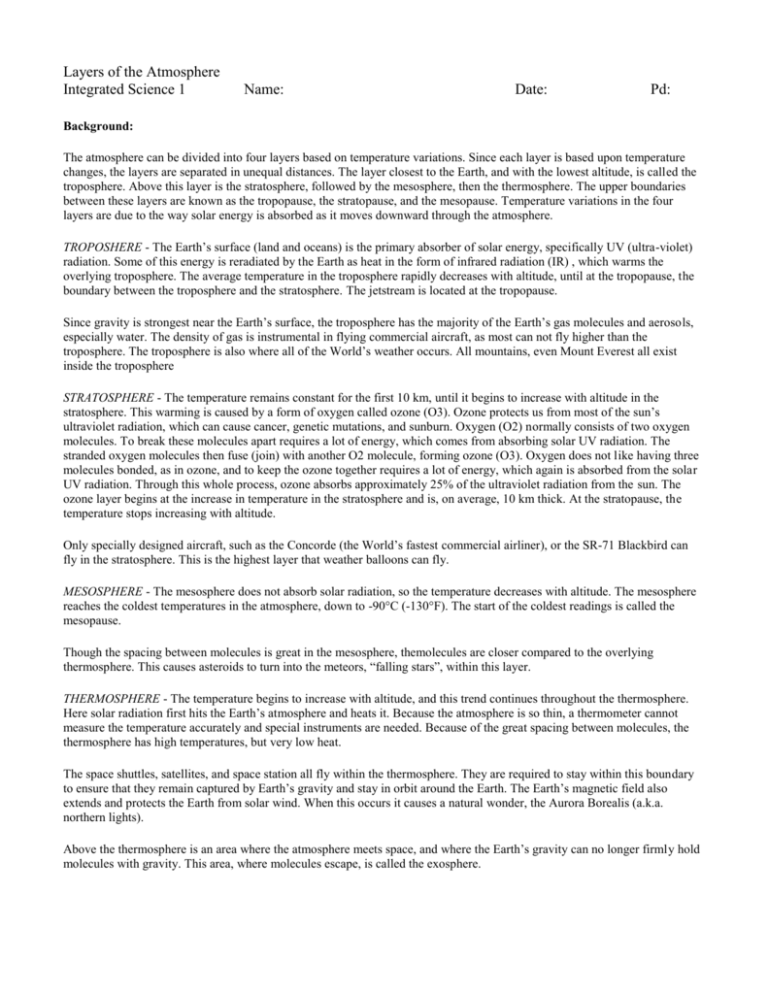
Layers of the Atmosphere Integrated Science 1 Name: Date: Pd: Background: The atmosphere can be divided into four layers based on temperature variations. Since each layer is based upon temperature changes, the layers are separated in unequal distances. The layer closest to the Earth, and with the lowest altitude, is called the troposphere. Above this layer is the stratosphere, followed by the mesosphere, then the thermosphere. The upper boundaries between these layers are known as the tropopause, the stratopause, and the mesopause. Temperature variations in the four layers are due to the way solar energy is absorbed as it moves downward through the atmosphere. TROPOSHERE - The Earth’s surface (land and oceans) is the primary absorber of solar energy, specifically UV (ultra-violet) radiation. Some of this energy is reradiated by the Earth as heat in the form of infrared radiation (IR) , which warms the overlying troposphere. The average temperature in the troposphere rapidly decreases with altitude, until at the tropopause, the boundary between the troposphere and the stratosphere. The jetstream is located at the tropopause. Since gravity is strongest near the Earth’s surface, the troposphere has the majority of the Earth’s gas molecules and aerosols, especially water. The density of gas is instrumental in flying commercial aircraft, as most can not fly higher than the troposphere. The troposphere is also where all of the World’s weather occurs. All mountains, even Mount Everest all exist inside the troposphere STRATOSPHERE - The temperature remains constant for the first 10 km, until it begins to increase with altitude in the stratosphere. This warming is caused by a form of oxygen called ozone (O3). Ozone protects us from most of the sun’s ultraviolet radiation, which can cause cancer, genetic mutations, and sunburn. Oxygen (O2) normally consists of two oxygen molecules. To break these molecules apart requires a lot of energy, which comes from absorbing solar UV radiation. The stranded oxygen molecules then fuse (join) with another O2 molecule, forming ozone (O3). Oxygen does not like having three molecules bonded, as in ozone, and to keep the ozone together requires a lot of energy, which again is absorbed from the solar UV radiation. Through this whole process, ozone absorbs approximately 25% of the ultraviolet radiation from the sun. The ozone layer begins at the increase in temperature in the stratosphere and is, on average, 10 km thick. At the stratopause, the temperature stops increasing with altitude. Only specially designed aircraft, such as the Concorde (the World’s fastest commercial airliner), or the SR-71 Blackbird can fly in the stratosphere. This is the highest layer that weather balloons can fly. MESOSPHERE - The mesosphere does not absorb solar radiation, so the temperature decreases with altitude. The mesosphere reaches the coldest temperatures in the atmosphere, down to -90°C (-130°F). The start of the coldest readings is called the mesopause. Though the spacing between molecules is great in the mesosphere, themolecules are closer compared to the overlying thermosphere. This causes asteroids to turn into the meteors, “falling stars”, within this layer. THERMOSPHERE - The temperature begins to increase with altitude, and this trend continues throughout the thermosphere. Here solar radiation first hits the Earth’s atmosphere and heats it. Because the atmosphere is so thin, a thermometer cannot measure the temperature accurately and special instruments are needed. Because of the great spacing between molecules, the thermosphere has high temperatures, but very low heat. The space shuttles, satellites, and space station all fly within the thermosphere. They are required to stay within this boundary to ensure that they remain captured by Earth’s gravity and stay in orbit around the Earth. The Earth’s magnetic field also extends and protects the Earth from solar wind. When this occurs it causes a natural wonder, the Aurora Borealis (a.k.a. northern lights). Above the thermosphere is an area where the atmosphere meets space, and where the Earth’s gravity can no longer firmly hold molecules with gravity. This area, where molecules escape, is called the exosphere. Directions: 1. Table 1 contains the average temperature readings at various altitudes in the Earth’s atmosphere. Plot this data on the graph on the worksheet, and connect adjacent points with a smooth curve. Be careful to plot the negative temperature numbers correctly. This profile provides a general picture of temperature at any given time and place; however, the actual temperature may deviate from the average values, particularly in the lower atmosphere 2. Label the different layers of the atmosphere and the separating boundaries between each layer. 3. Mark the general location of the ozone layer. You should place eight words on your graph in the correct locations: troposphere, tropopause, stratosphere, stratopause, mesosphere, mesopause, thermosphere and ozone layer. 4. Neatly draw in each of the drawings in table 2 in their appropriate place within the correct layer. Questions: 1. What is the basis for dividing the atmosphere into four layers? 2. Does the temperature increase or decrease with altitude in the: troposphere _______________ stratosphere _______________ mesosphere _______________ thermosphere _______________ 3. What is the approximate height and temperature of the: tropopause _______________ _______________ stratopause _______________ _______________ mesopause _______________ _______________ 4. What causes the temperature to increase with height through the stratosphere? 5. What causes the temperature to decrease with height through the mesosphere? 6. What causes the temperatures in the lower troposphere to be warmer? 7. Which layer of the atmosphere is the closest to the Earth? 8. Which layer is the farthest away? 9. Which atmospheric layer contains the coldest temperatures? 10. Which atmospheric layer has the highest temperatures? 11. Approximately how thick is the Earth’s atmosphere? 12. Which layer(s) contains the ozone layer? 13. What happens to the temperature at the tropopause? 14. Which layer contains clouds, wind, rain, snow and most weather patterns? 15. Which layer is the densest?


